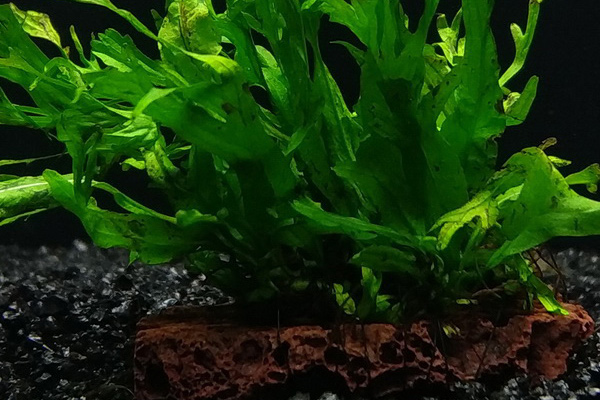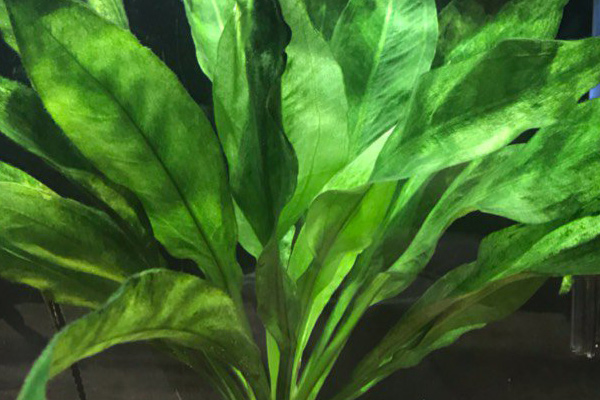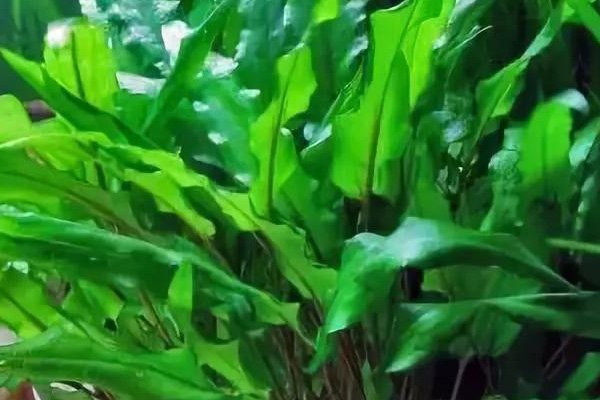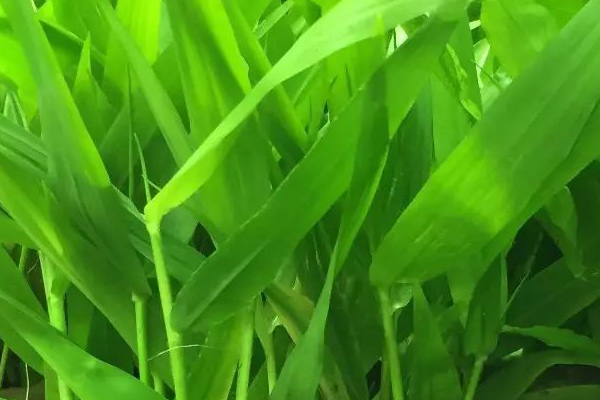Amazon Sword: Grow & Care for Amazon Sword
Written by Iris
Jan 20 2023

Amazon Sword is produced in Brazil. It is a large grass. The leaf length of Amazon Sword can reach 40 cm and the leaf width is 3 cm. Amazon Sword can grow continuously and fulfill a one-meter fish tank in the end. It is also known as the king of tropical aquatic plants and are a variety of tropical plants. The most easily cultivated aquatic plants.
We recommend keeping Amazon swords in an aquarium that holds 20 to 30 gallons instead. Larger freshwater tanks offer more vertical space for leaf growth. Plus, the plant won't overcrowd any tank inhabitants.
You can keep the plantlets in a submerged condition that will help the plant grow faster with better development. During the propagation period, try to place the developed plantlets in the soil substrate and secure the plantlets of the tree with small stone chips or rocks. Never cut off an underdeveloped young plant or plantlets. Moreover, if you find the small plantlets appearing yellowish then don’t panic because the young sword plants are usually yellow in color. You can use liquid plant nutrition as the foods for the growth of the plant like
However, your Amazon sword light needs may vary depending on the size of your aquarium. So to determine how many watts you need your bulb to produce, divide the total number of watts from a light source by the gallon size of your fish tank. For instance, a 60-watt bulb would offer 3 watts per gallon in a 20-gallon tank. That said, remember too much light will encourage algae growth, therefore, leave your aquarium bulb on for not more than 12 hours per day. Also, consider using a moderate light source instead of a high light fixture.
(Read More: How to Trim & Prune Amazon Sword)
Excess algae growth can be caused by aquarium water conditions and excessive light. So make sure water conditions are satisfactory by testing often and conducting regular partial water changes. And keep levels of visible organic materials and waste from building up. The issue of excessive lighting can be a challenge because this plant likes strong light for long hours. The lighting requirements for this plant make it all the more important that water conditions are as good as they can be.
An Amazon Sword Plant may have a small, stubby rhizome. Its stems are on the short side and its leaves on the long side. Young leaves grow out from the center of the plant, unfolding from the middle. This makes the older leaves being the ones on the outer layers. Young leaves are usually thin and light green when they first come out, turning thicker and darker green as the leaves mature.
Amazon Sword stems are sturdy but their leaves can be delicate. Leaves can crack or tear easily and they cannot repair themselves. Leaves also can turn yellow. Yellow leaves can be from poor tank conditions. This may also mean the plant needs nutrients, so look for plant fertilizer containing iron.
If leaves turn brown, clear, or become covered with algae, gently trim them off close to the bottom of the stem, trying not to disturb the rest of the plant.
Gigantea Sword – Originated in Argentina and Brazil, this plant is also a freshwater plant-like Amazon Sword, and comfortable to propagate in soft water under strong light. This aquatic plant is a perfect background for small and shy fish in the tank that likes to hide behind the shrubs.
Pygmy Chain Sword – This tropical plant is a rapid spreader because if you propagate one then it will grow more branches in the tank. Bottom-dwelling fish love to stay on the leaves of this tree.
Red Mellon Sword – The color of this plant is light-red, which creates beauty in an aquarium. The water temperature should be medium while placing these plants.
Spade-Leaf Sword Plant – The leaves of this North American aquatic plant are circular and broad in shape. This is also prone to algae-like Amazon Sword, so you need to be careful with the cleanliness while placing this plant in the tank.
However, the plant is quite hardy and will handle a reasonable number of aggressive species though not as rough as Oscars, Jack Dempsey, and large cichlids.
Fish that snack on live plants are not the best in tanks planted with Amazon sword especially when planted as a decorative element in your tank.
Add Amazon sword in aquariums with fish that love heavily planted tanks like betta and gouramis. The numerous leaves also provide great cover for small fish trying to avoid bullies and young fry in danger of being consumed.
On top of that, Amazon sword does well with or without other plant companions. However, due to its large size and the possibility of outgrowing its designated space, you should consider putting it with smaller aquarium plants.
How to Choose and Prepare a Planting SiteHow to Grow Amazon SwordHow to Care for Amazon SwordWater Type for Amazon SwordLighting for Amazon SwordFilter for Amazon SwordSubstrate for Amazon SwordTrimming & PruningSupplements for Amazon SwordCommon Problems With Amazon SwordAlgae Growth On Amazon Sword LeavesYellow and Cracking LeavesSword Plants VarietiesAmazon Sword Tankmates
How to Choose and Prepare a Planting Site
Amazon swords can grow in small 10-gallon gallon tanks. An aquarium of that size provides more than enough space to let the plant spread while still maintaining stable water parameters. However, an aquarium of that size isn't enough to let the plant reach its full potential. It’s not a great size if you plan on having many fish either.We recommend keeping Amazon swords in an aquarium that holds 20 to 30 gallons instead. Larger freshwater tanks offer more vertical space for leaf growth. Plus, the plant won't overcrowd any tank inhabitants.

How to Grow Amazon Sword
The breeding or propagation of this plant is very simple without any hassles. These plants develop long maternal stem, and the plantlets appear on the stem. After some days, the tiny plantlets will start developing their roots with a couple of leaves.You can keep the plantlets in a submerged condition that will help the plant grow faster with better development. During the propagation period, try to place the developed plantlets in the soil substrate and secure the plantlets of the tree with small stone chips or rocks. Never cut off an underdeveloped young plant or plantlets. Moreover, if you find the small plantlets appearing yellowish then don’t panic because the young sword plants are usually yellow in color. You can use liquid plant nutrition as the foods for the growth of the plant like
- Seachem Flourish Excel
- Flourish Trace

How to Care for Amazon Sword
Water Type for Amazon Sword
For every aquatic plant, the water temperature should be checked before you keep the plant in your aquarium. Follow some necessary requirements to set a tank of amazon sword Plant.- Temperature
- pH Level
- Hardness
- Replacement Procedure
Lighting for Amazon Sword
Amazon sword doesn't need strong lighting though more light will result in faster growth albeit boosting algae growth. The best light bulb for an aquarium planted with Amazon sword should produce at least 2 watts per gallon of full-spectrum light that is between 5000K and 7000K. The plant will also need the light to be on for between 10 and 12 hours per day, this includes the light coming from the sun in case your fish tank is in a well-lit room.However, your Amazon sword light needs may vary depending on the size of your aquarium. So to determine how many watts you need your bulb to produce, divide the total number of watts from a light source by the gallon size of your fish tank. For instance, a 60-watt bulb would offer 3 watts per gallon in a 20-gallon tank. That said, remember too much light will encourage algae growth, therefore, leave your aquarium bulb on for not more than 12 hours per day. Also, consider using a moderate light source instead of a high light fixture.
Filter for Amazon Sword
It is a known fact that plants are natural filters; however, a mechanical filter will help reduce the load of filtration effort from the plants. Ensure you keep a normal filtration system in the tank so that it can help wash out pollutants out of the tank water.Substrate for Amazon Sword
This plant grows best in the loosely packed substrate or a good alternative like Aquarium gravel. The chosen substrate should have a depth of 2.5 – 3 inches (6 – 8 cm) at the base of the tank. The reason for this is because the Amazon Sword Plant’s roots will grow to be quite large and extensive, growing deep and wide in the tank. Therefore, having enough substrate depth will help to accommodate this plant and ensure that it stays rooted properly. ADA Amazonia soil, Caribsea Eco-Complete Aquasoil, Seachem Flourite Black Sand, etc. are excellent choices and they are rich in essential nutrients. If you have sand or gravel, it is still possible to keep Amazon Sword Plant. However, you will have to use root tabs to provide the necessary nutrients to the plant.Trimming & Pruning
Thanks to its slow-paced growth, trimming and pruning is not something you have to worry about with Amazon swords. Other than aesthetic trims to keep the plant looking clean, this isn't an area where you'll be spending a lot of time. You can trim off old growth as the plant ages. Older leaves are closer to the outside of the bush. Just pluck the entire leaf off to make way for new development. It's also a good idea to remove any diseased leaves since Amazon swords can succumb to infection. When this happens, the leaves usually turn black and frayed. Remove the affected leaves to prevent the disease from spreading to the base of the plant. Beyond that, just let the plant grow! The main priority for Amazon swords is space. Use trimming to avoid overcrowding. If the plant has ample room to thrive, you won’t have to perform pruning at all.(Read More: How to Trim & Prune Amazon Sword)
Supplements for Amazon Sword
CO2 and fertilizer application: amazon sword plant does not require CO2 for healthy growth. However, adding them will significantly increase the growth rate. Fertilizer application also depends on the tank setup. For example, if your substrate is rich with minerals, it can be enough. In other cases, the plant will not perform too well in tanks without fertilizer application. So, you will have to add some from time to time to maintain a normal growth rate and overall good health. Iron and potassium supplements will help it maintain its appealing green coloration and healthy leaf structure, while the additional pressurized CO2 dosing will ensure it grows fast and wider.
Common Problems With Amazon Sword
Algae Growth On Amazon Sword Leaves
Because the Amazon sword plant leaves are slow growing, last a while, and love strong light for long hours, they are susceptible to algae growth. If algae growth becomes an issue, its not advisable to attempt to wipe the algae growth off the leaves because they may crack. Instead, its a good idea to have some Amano Shrimp, Red Cherry Shrimp, Nerite Snails, Mystery Snails or Otocinclus Catfish to help keep algae growth in check.Excess algae growth can be caused by aquarium water conditions and excessive light. So make sure water conditions are satisfactory by testing often and conducting regular partial water changes. And keep levels of visible organic materials and waste from building up. The issue of excessive lighting can be a challenge because this plant likes strong light for long hours. The lighting requirements for this plant make it all the more important that water conditions are as good as they can be.
Yellow and Cracking Leaves
Its not uncommon for some Amazon Sword leaves to begin to die soon after being added to a tank. If this happens, don’t panic. Just gently trim the dead or dying leaves at the stem from the bottom of the plant. As long as all other conditions are proper, the plant should adjust to its new home and begin to grow new leaves.An Amazon Sword Plant may have a small, stubby rhizome. Its stems are on the short side and its leaves on the long side. Young leaves grow out from the center of the plant, unfolding from the middle. This makes the older leaves being the ones on the outer layers. Young leaves are usually thin and light green when they first come out, turning thicker and darker green as the leaves mature.
Amazon Sword stems are sturdy but their leaves can be delicate. Leaves can crack or tear easily and they cannot repair themselves. Leaves also can turn yellow. Yellow leaves can be from poor tank conditions. This may also mean the plant needs nutrients, so look for plant fertilizer containing iron.
If leaves turn brown, clear, or become covered with algae, gently trim them off close to the bottom of the stem, trying not to disturb the rest of the plant.

Sword Plants Varieties
Other than Amazon Sword Plants, there are varieties of Sword Plants that you can keep in your aquarium to provide a beautiful and eco-friendly ambiance:Gigantea Sword – Originated in Argentina and Brazil, this plant is also a freshwater plant-like Amazon Sword, and comfortable to propagate in soft water under strong light. This aquatic plant is a perfect background for small and shy fish in the tank that likes to hide behind the shrubs.
Pygmy Chain Sword – This tropical plant is a rapid spreader because if you propagate one then it will grow more branches in the tank. Bottom-dwelling fish love to stay on the leaves of this tree.
Red Mellon Sword – The color of this plant is light-red, which creates beauty in an aquarium. The water temperature should be medium while placing these plants.
Spade-Leaf Sword Plant – The leaves of this North American aquatic plant are circular and broad in shape. This is also prone to algae-like Amazon Sword, so you need to be careful with the cleanliness while placing this plant in the tank.
Amazon Sword Tankmates
Amazon sword plant is generally a good choice for a community fish tank especially one with calm fish that won’t damage plant parts.However, the plant is quite hardy and will handle a reasonable number of aggressive species though not as rough as Oscars, Jack Dempsey, and large cichlids.
Fish that snack on live plants are not the best in tanks planted with Amazon sword especially when planted as a decorative element in your tank.
Add Amazon sword in aquariums with fish that love heavily planted tanks like betta and gouramis. The numerous leaves also provide great cover for small fish trying to avoid bullies and young fry in danger of being consumed.
On top of that, Amazon sword does well with or without other plant companions. However, due to its large size and the possibility of outgrowing its designated space, you should consider putting it with smaller aquarium plants.
Latest Updated
- Benefits of Bugleweed - 7 Science-backed Health Benefits
- Bugleweed Dangers & Side Effects - Is It Poisonous?
- How to Plant Evergreen Trees - What You Should Know
- When to Plant Evergreens - Grow Guide for Evergreen Trees
- 12 Wonderful Evergreen Shrubs for Your Garden
- 12 Popular Evergreen Plants with Pictures for Beginners
- When And How To Prune A Lilac Bush Like a Pro
- How to Grow & Care for Lilac Vine (Hardenbergia Violacea)
- Japanese Lilac Tree (Syringa Reticulata) Care & Propagation Guide
- Shumard Oak Pros and Cons - What to Know
Popular Articles
- Winter maintenance of Antirrhinum Majus
- How to Grow Terminalia Mantaly Tree
- How to Grow and Care for Crossostephium Chinense
- How to grow Antirrhinum Majus in spring
- Peristeria Elata (Dove Orchid) Profile: Info & Care Guide
- Underwatered Snake Plant (Sansevieria Trifasciata) - Signs And How To Fix
- How to Care for Brazilian Jasmine Plant (Mandevilla Sanderi)
- How to Grow & Care for Graptopetalum Purple Delight in Summer
- Rosa Chinensis (China Rose): Plant Growing & Care Tips
- How to Care for Baby Sun Rose (Aptenia Cordifolia)